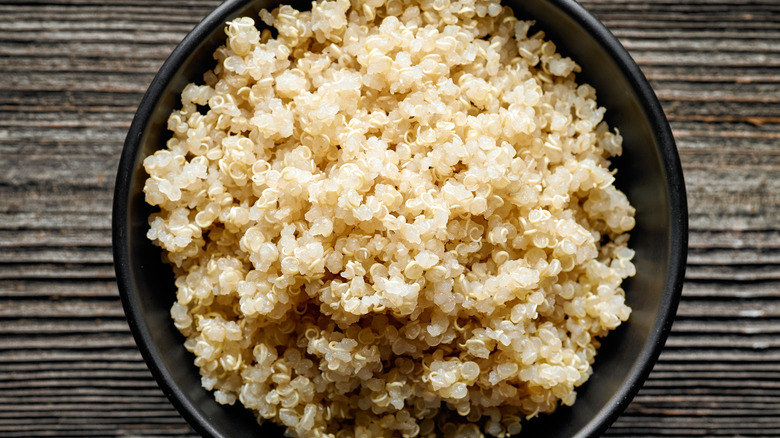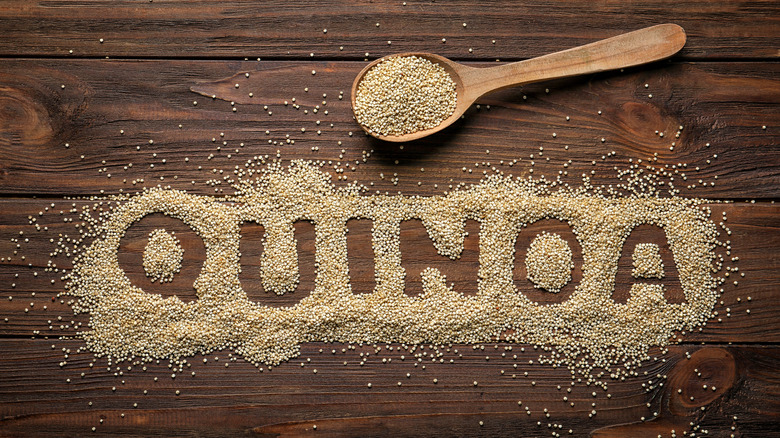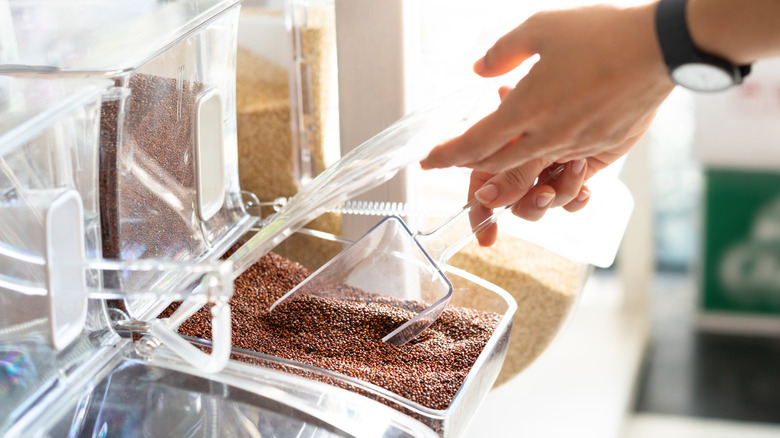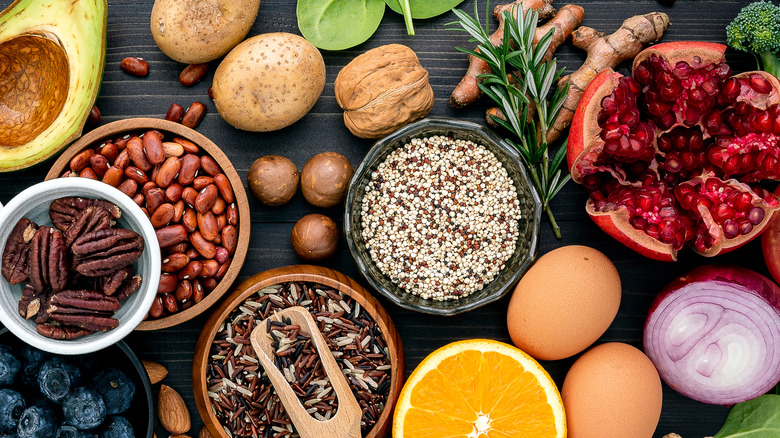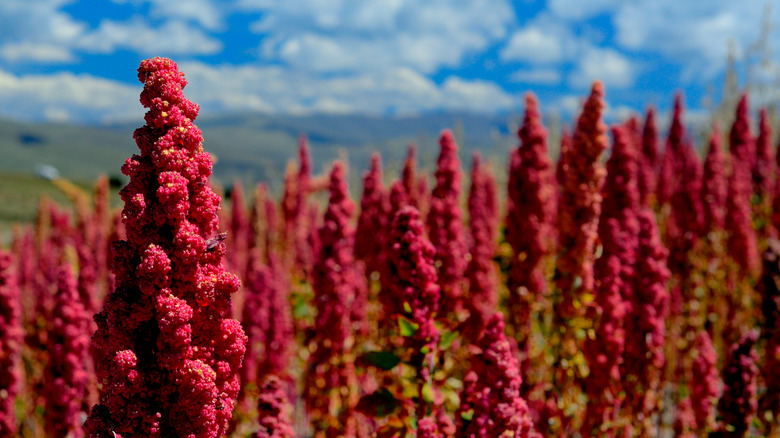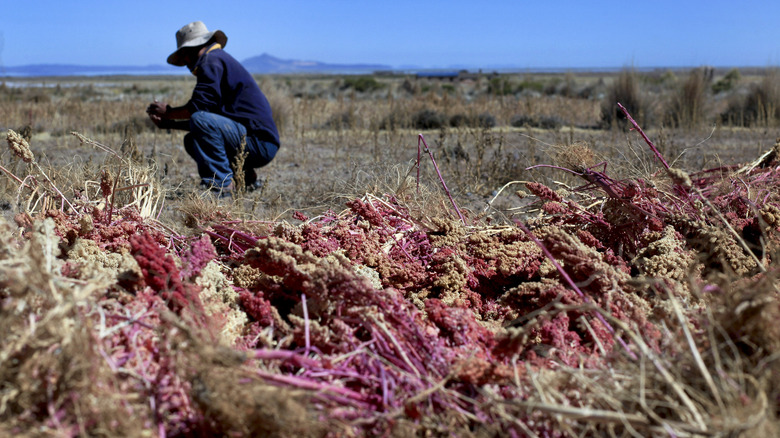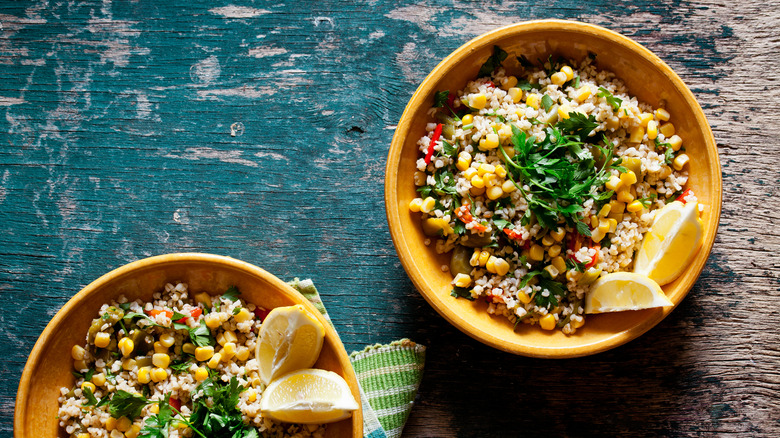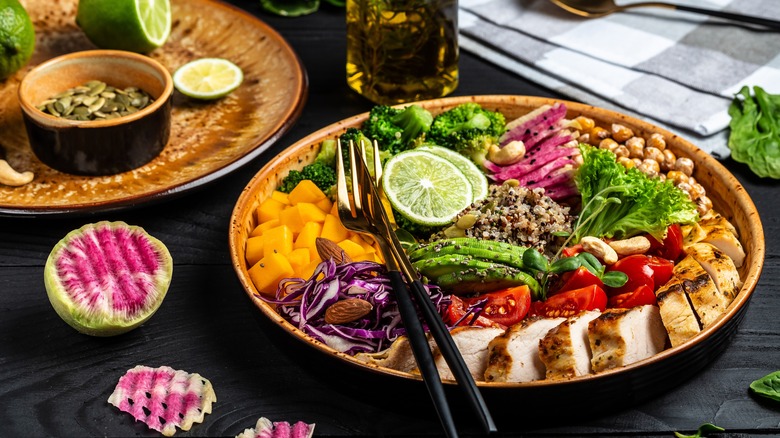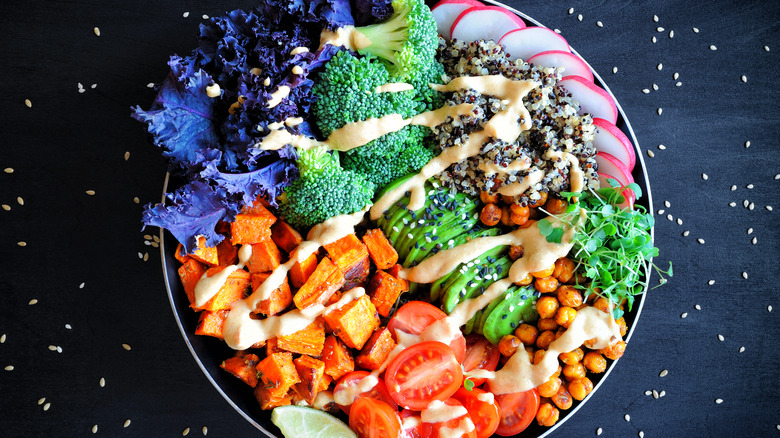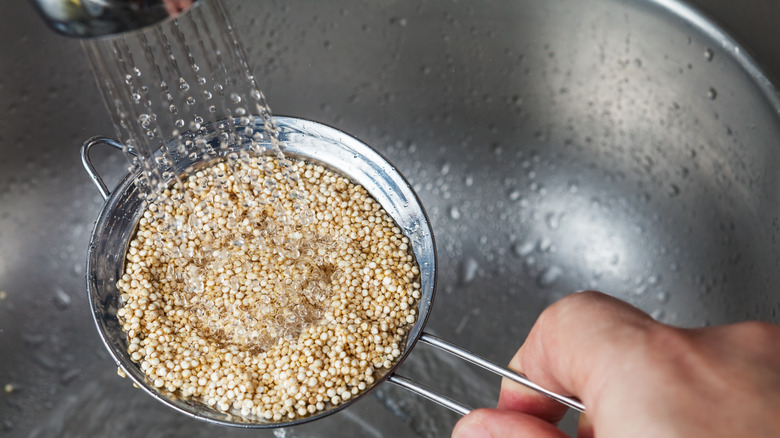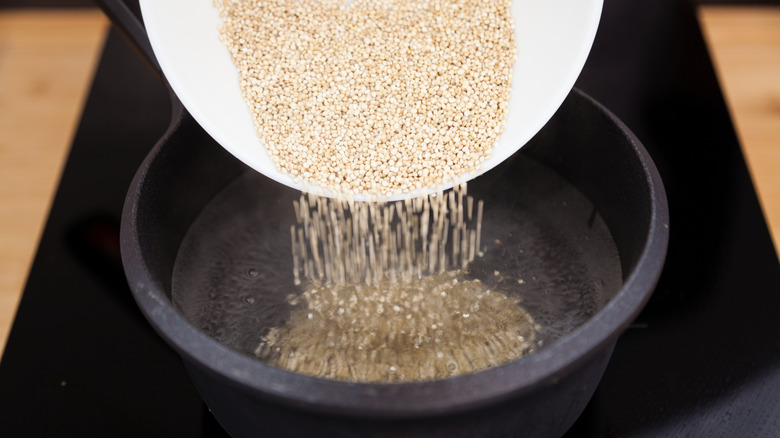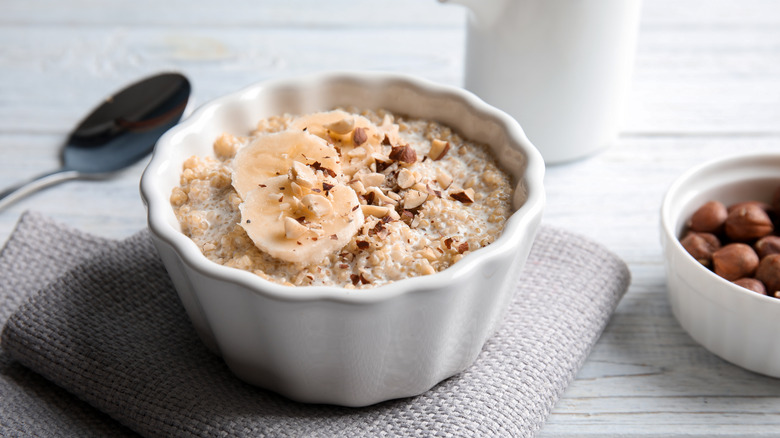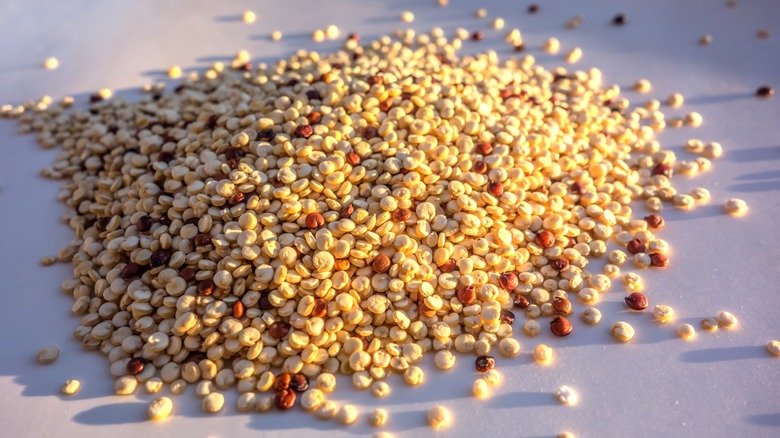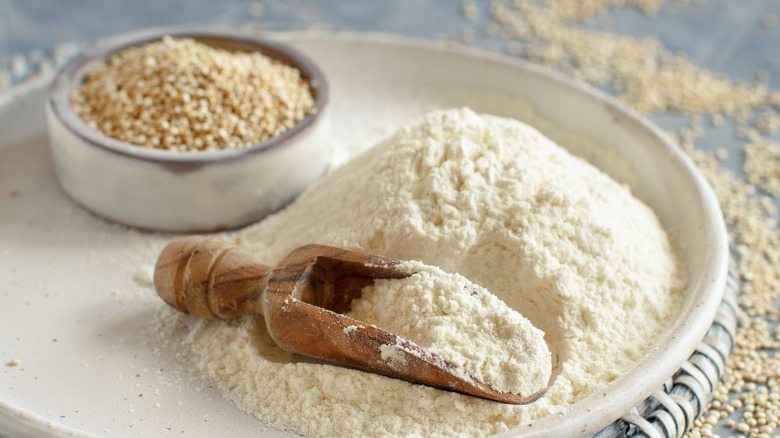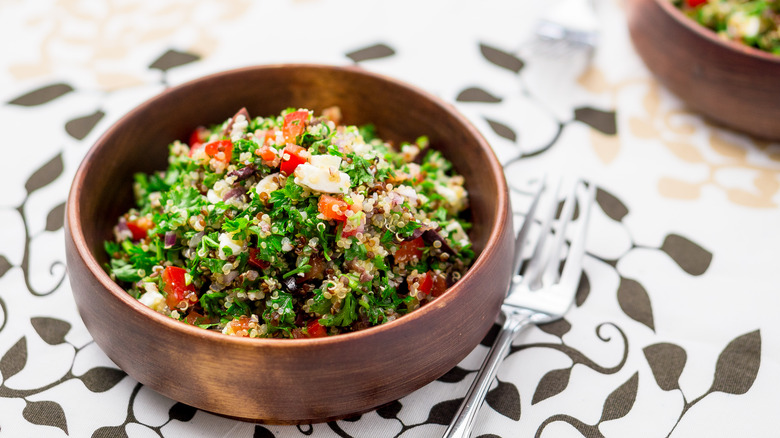Everything You Need To Know About Quinoa
A decade ago, it was a true surprise to find quinoa even in the depths of a health food store, or on the menu of a hippie restaurant. Most Americans could barely pronounce it, let alone understand what it was or how to cook with it. Today, quinoa is everywhere, and we are here for it. Even though it's accessible, accepted, and well-loved, there is still quite a bit of mystery surrounding the superfood, so it's time we set the record straight and explained everything you need to know about quinoa, America's favorite rice substitute.
While quinoa newbies may think of it as a grain found in salads and Buddha bowls, in reality, it is so much more. Quinoa is an extremely versatile, nutrient-dense superfood that amounts to more than just a trendy fad item that comes and goes with the times. And although it seemed to have appeared out of nowhere, quinoa has had an incredible historical and cultural influence on ancient societies and has been a South American staple for centuries.
How to pronounce quinoa
When foods come in and out of fashion, it can be hard to keep up with the latest trends and pronunciation. In case you are curious, we've broken down exactly how to pronounce this famous superfood and the reason why it is so hard to say.
Since its resurgence in popularity, modern America has struggled with the pronunciation of the word quinoa. Queen-wah? Keen-oh-wah? Kin-oh-ay? Keen-ee-huah? As it turns out, you may have been pronouncing quinoa wrong this entire time. Don't feel embarrassed if you don't know how to say the trendy superfood's name; you're not alone. Quinoa has stepped back onto the scene after a long hiatus in the United States, and it's been through a few styles of pronunciations and language adaptations since. Originally, quinoa was spelled 'kinuwa,' then was later adapted by the Spanish to 'quinua'. Today, the accepted pronunciation is "keen-wah" with an emphasis on the first syllable.
Buying and storing it
Trendy food items are often difficult to find in American grocery stores because they are so new to the scene and our American society hasn't necessarily quite figured out a way to categorize them yet. Furthermore, each grocery store tends to have a different organizational method, even for standard items. Ever try to find dried mushrooms, chia seeds, or tahini in a market you're not familiar with?
Luckily, there are only a few places quinoa might be hiding at your local grocer. Start by checking in the aisle with grains like rice, risotto, farrow, and barley. If you are flat out of luck, make your way over to the "organic and natural" section, if you're lucky enough to have one. Oftentimes, trendy superfoods seem to be clumped in with this section alongside goji berries, flaxseed, and kale chips. If you're a member or patron of a local food co-op or grocery store that offers bulk items, check those bins. Several varieties of quinoa can typically be found in this section. When in doubt, ask a staff member to give you a helping hand. We can almost guarantee that it's hiding somewhere. Once you get it home, store the quinoa in a dry, cool place.
It's a superfood
Although the word gets thrown around quite a bit, the truth about superfoods is that they don't fall into some sort of top doctor-approved list. The term was simply coined to describe foods of particularly high nutrient contents that promote healing. Certain foods like kale, blueberries, and flaxseed are obvious superfoods, while others are up to the diner's discretion. People everywhere have seemed to embrace quinoa with open arms as a superfood, and we agree. But, is quinoa nutritious?
Quinoa is loaded with fiber, protein, manganese, phosphorus, magnesium, folate, and thiamine, per Harvard T.H. Chan. It also contains all nine essential amino acids, which aren't always found in plant proteins. It is a plant-based whole food that is quite accessible, and, in most cases, is quite affordable. It's safe to say that this superfood is popular for a reason, can be a healthy swap for other grains and starches, and is universally loved.
It's not a grain
Contrary to popular belief, quinoa is not a grain. Yes, it might make its way onto grain bowls, hide in the grains section at the grocery store, or be used as a popular swap for rice. But the truth is, it's a seed masquerading as a grain, and it has the bulk of our population fooled. So, what is quinoa if not a grain?
This superfood is actually a seed, considered a pseudo-cereal or pseudo-grain, per PubMed. This is because quinoa is harvested from the tops of plants, which seem to take an almost flower-like appearance. The leaves are also edible, and the plant itself is related to sugar beet and spinach in the goosefoot family, says Ancient Grains. When quinoa is cooked, you may notice that a little tail-like curly sprig emerges from the seed. This is its sprout, ready and waiting to grow its own quinoa plant. That means that what we know as edible quinoa is classified as a seed, even if we consider it to be a grain. There are hundreds of varieties of quinoa that come in all colors, but white, red, and brown quinoa are typically sold at grocery stores in the United States.
This shouldn't influence how you cook or enjoy the plant, but, rather it is a fun fact to know, especially if you are on a grain-free diet.
The origin story
While we'd like to think of quinoa as this new-fangled pantry item that cities like San Fransisco and New York City popularized, it's actually been a part of our history all the way back to ancient times. Starting with the Incas 5,000 years ago, quinoa was highly revered, harvested, and used as a primary staple in their diet, per Ancient Grains. It later became an important part of the Quechua and Aymara cultures, as well.
Because quinoa plants are hearty and grow well in rocky soil and high altitudes, it was easily accessible and was an important source of nutrients for ancient civilizations. Unfortunately, explorer Francisco Pizarro in his quest to whip out the native populations, destroyed as much of the crop as he could find. It wasn't until the 1970s that quinoa became popularized in the modern United States, and from there it took off. To this day, South America continues to produce the most quinoa.
Quinoa fits into most diets
Luckily for those who suffer from food allergies and celiac disease, quinoa is very allergen friendly. Because it's a seed, not grain, there is no fear of gluten contamination. In addition, quinoa is vegan, meaning it's made without animal meat or byproducts. While this may seem like a no-brainer, unexpected foods like palm oil which appear to be vegan are not because the harvesting process destroys orangutang habitats. No animals were harmed in the making or harvesting of this pseudo-grain.
While quinoa is technically not a grain, the paleo community still reveres it as such and does not recommend it to those following the diet, per Paleo Comfort Foods. Most paleo advocates agree that it's considered to be okay in moderation for those not following the diet too strictly, but in general, most of the communities still consider it to be grain-like because of its high carbohydrate content. All in all, quinoa can be eaten by almost anyone and doesn't make the list as a top allergen to look out for.
It has recently resurged in popularity
Quinoa has been a staple in South American cultures for thousands of years, so it's incorrect to say that it was an unpopular food until now. The truth is that it finally gained the recognition it deserved in North America at a much later date, and only recently become a trendy superfood in the United States. In fact, a new study found a growing interest in ancient grains among Americans in general. And while urbanized areas are more likely to carry it in their grocery stores or serve it in their restaurants, it has become quite accessible everywhere.
It seems quinoa has taken a front seat when it comes to ancient grains, and with it, demand has gone through the roof over the last decade. Quinoa used to be incredibly inexpensive, but prices have soared, and larger players have entered the game, edging out local quinoa farmers that ultimately supported the industry for centuries, per NACLA. When purchasing the superfood, try to learn everything you need to know about quinoa so you can make informed decisions about purchasing from indigenous cooperatives and companies.
Quinoa is a vehicle for flavor
For those of you who have never experienced the wonders of quinoa, it can best be described as having a spongy, chewy texture with less density than rice. The seeds are quite small, each about the side of a sesame seed. Quinoa comes in many varieties, so it's not surprising to see it in white, black, red, brown, or anything in between. White quinoa tends to be popular, but tri-colored quinoa is available in most grocery stores.
Like rice, quinoa is a vehicle for flavor and does incredibly well when doused in a sauce or dressing. Often, quinoa is accompanied by raw or roasted vegetables, minced herbs, and dressings like tahini, lemon, garlic, or dijon. The grain itself absorbs the sauce and retains its flavor quite easily, so try mixing it in pesto, marinara, chimichurri, or tzatziki. Uncooked quinoa can be toasted and used as a crunchy topping to just about anything from granola to roasted eggplant. Because quinoa can come in all textures and colors and has a relatively mild grain-like flavor, it pairs well with dishes both savory and sweet.
To rinse or not to rinse?
Quinoa contains a natural coating of saponin, a natural compound found in many species of plants, per The National Library of Medicine. It's safe in small quantities but has an unpleasant bitter flavor that is described by some as sharp or soapy. The natural coating protects the plant and is a key player in the evolution of quinoa. Luckily, it rinses right off with just a little water. Simply place your quinoa in a fine-grated strainer, and use cold water to rinse the quinoa. If you'd like to be more thorough, submerge the pseudo-grain in cold water for a few minutes and agitate the water before straining it.
It is not necessary to rinse quinoa, so if you haven't been doing it all along, there is no reason to worry about toxicity. This is a mistake everyone makes with quinoa, so you're not alone. At most, you notice a pleasant change in flavor when you start rinsing.
It's quick and easy to cook
There are plenty of reasons to love quinoa, including its mild flavor, nutrient density, and unique texture. But an unexpected bonus is that it is incredibly easy to cook. While rice can take anywhere from 15 to 45 minutes to cook, quinoa takes about 10 to 15 minutes, tops.
After rinsing quinoa with cold water to remove the bitter saponin, place it in a pot with double the amount of water to quinoa. Cover the pot, bring it to a boil, and then lower it to a light simmer for about 10 minutes, or until the little sprouts that look like tails start to emerge from the seeds. At this time, avoid the biggest mistake that's made when cooking quinoa by letting it rest. To do this, turn the heat off, and let it sit for up to 15 minutes. The last step is to fluff the quinoa, by breaking it up and mixing it with a utensil like a fork. This ensures evenly-cooked, fluffy quinoa every time.
Prepare it for breakfast
Originally, quinoa was a breakfast staple of South America. It's often called a pseudo-cereal and has a similar likeness to buckwheat cereal, cream of wheat, grits, and other hot cereals. It differs from your typical porridge because the superfood tends to be less creamy, and doesn't form the almost slimy binding film that oatmeal and buckwheat produce. When preparing quinoa for breakfast, treat it like you would rice. Add warm milk or plant-based milk, dried fruits like raisins and dates, nuts, seeds, and fresh fruits. Try flavoring the mixture with cinnamon, pure vanilla extract, nutmeg, and other typical breakfast spices. A pinch of salt goes a long way, and the addition of ground flax meal can give it that creamy texture quinoa seems to lack.
There's nothing better on a cold day than warm and nutty cinnamon breakfast quinoa. Try adding sliced apples in the fall, blueberries, and strawberries in the summer, and currents, figs, and dates in the winter.
Toast quinoa
Part of quinoa's appeal is its unique versatility. The seed, like most, can be toasted and used to give texture to a dish. Toasted quinoa can be used in sweet dishes like granola bars, oatmeal, muffins, bread and sweet bread, and cookies. It has a warm, nutty, and mild flavor, and a crunchy texture.
For savory dishes like grain bowls, salads, cooked proteins, and roasted vegetables, toasted quinoa can make an incredible topping. Colored quinoa can be especially aesthetically pleasing and can add an element of crunch or crispiness to dishes without deep frying or the use of hot oils. For those who have Celiac Disease or avoid gluten, toasted quinoa can make a pleasant breading or add a familiar crispiness that many gluten-free foods are lacking. There are many reasons you should consider toasting quinoa including enhanced texture and aesthetic of any dish. In addition, quinoa gives food a nutrient boost of fiber and protein.
To toast quinoa, simply keep it moving around a hot, un-oiled pan until it starts to become fragrant, or brown. You can also use an oven or toaster oven and roast it for about 10 minutes at 350 F. Consider moving the quinoa around the pan at the halfway mark and keep a close eye on the oven to prevent burning.
Make and use quinoa flour
Perhaps the most innovative and unique use of quinoa is quinoa flour, which is incredibly simple to make and serves a variety of purposes. Quinoa flour is a godsend for gluten-intolerant folks because it can be used in pretty much anything from baked goods to pizza crust. Un-rinsed quinoa flour does have a mildly bitter flavor, so be sure to take the time to rinse the seeds before diving into your baking project.
The density of quinoa flour is perfect for making gluten-free pizza crusts or bagel thins. Simply blend a 1-to-1 ratio of rinsed white quinoa with cold water until it's creamy smooth. Add spices and aromatics like salt, pepper, basil, garlic, or onion powder for flavoring, and you can even add everything-but-the-bagel seasoning for your bagel thins. Use parchment paper on an oven pan, and smear the batter out in a thin layer, in the shape you'd like to use. Use one large circle, oval, or rectangle for a pizza crust, and small O's for bagel thins. Roast the batter at 375 F for about 20 minutes or until it browns, then slowly pry the crust off the parchment paper, flip it, and roast for another 10 minutes. Add a little olive oil before the second roasting. The crispier the better! Add your pizza toppings and return them to the oven until everything is warm, bubbly, and ready to eat.
Tasty pairings
If you're new to the world of quinoa, start by using it as a rice replacer. You can't go wrong, because everything that pairs well with rice, pairs well with quinoa because of its similar texture and flavor. While there is no single best way to cook quinoa, there are a variety of options for the versatile pseudo-grain.
For those of you looking to be a little more experimental with your new favorite superfood, try using it as a base for a grain bowl, top it with your favorite vegetables, and douse it with dressing or sauce. With this simple formula, you can't go wrong. Other Southern American staples like sweet potatoes, corn, beans, squash, and leafy greens are always a safe bet, as regional and seasonal produce tends to go well together.
Mediterranean flavors like tomatoes, feta, oregano, lemon, and olive oil are popularly mixed with quinoa, as well. Add cooked and chilled quinoa to salads to beef them up, or let quinoa cook in soups to add substance and texture. The options are limitless, but when in doubt, treat quinoa like the grain it's pretending to be.
